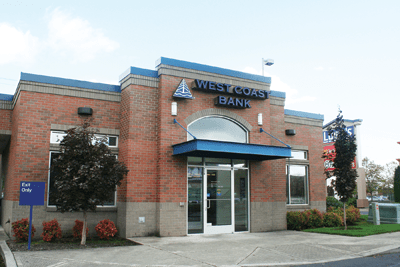The combination of continued low interest rates, government regulations and the sheer number of banks, both regionally and throughout the US, could produce more mergers such as the recently announced Tacoma-based Columbia Banking System Inc. purchase of Lake Oswego-based West Coast Bancorp, in a transaction valued at $506 million.
The merger trend “will continue until the excess in the number of bank charters is reduced to a point that national banks, community banks and credit unions can all serve their respective markets and make a reasonable profit in the process,” summarized Heritage Bank Market Executive Brett Bryant. “The U.S. banking landscape is still far from this equilibrium and small bank boards and management teams are facing exhaustion.”
A bank’s profit is made primarily on the spread between deposit rates (what the bank pays depositors) and loan rates (what the bank earns). With rock-bottom deposit rates and falling loan rates, experts say that Net Interest Margin (NIM) spread is being squeezed.
“It is almost intuitive to assume that low interest rates are good for banks,” said Bryant. “In fact, normal business cycles where rates fluctuate over a 5 to 7 year time frame are what bankers consider normal. The prospect of these current low rates over a period of several years, while good for borrowers, is severely damaging banks ability to make money.
“The Federal Reserve has stated they want this to continue for a few more years,” added Bryant. “That reality alone will force many more banks to seek viable partners via acquisition. Heritage Bank has a well communicated strategy to acquire banks that seek this type of partnership.”
Bryant expressed his personal opinion that a bank will need at least $2.5 billion in assets to be successful going forward. He assured that Heritage Bank “has accumulated more than adequate capital to reach this minimum asset base and beyond.”
Adding to banks’ concerns will be the upcoming (and not yet announced) precise costs of compliance to the Dodd-Frank Wall Street Reform and Consumer Protection Act, signed into federal law by President Obama July 21, 2010.
“This legislation is not yet 50 percent implemented and has brought, and will bring, significant new expenses,” said Bryant. “There is much discussion about the minimum size that will be required to absorb these new costs.”
“The industry needs consolidation,” noted Raymond Davis, CEO and President of Portland-based Umpqua Bank. “This interest rate environment, if continued, will make a lot of people take a longer term view of their potential earning.”
Though Davis emphasized that no one has a crystal ball with which to accurately predict future transactions, he observed that institutions are seeing the pressure of inability to grow.
“Those who act now to find others with capital will be the winners,” he said. “For those who wait, it is very possible there may not be buyers.”
Tami Nesburg, senior vice president and Vancouver regional manager at Regents Bank, sees a similar possible scenario, with mergers and acquisitions involving both large and small institutions.
“From our perspective, the market continues to stay soft with minimal growth and compressed margin with very low rates,” said Nesburg. “In those conditions, many institutions just can’t continue to operate. When someone comes with a strong capital position, they can really help.”
Banks, especially the stronger ones, will definitely be looking at each other, according to Tom Unger, Wells Fargo & Co. vice president and Oregon region manager of corporate communications.
According to the newest FDIC deposit statistics released June 30, 2012, the top banks by market share for Clark County are JP Morgan Chase Bank at 16.58 percent, Sterling Bank at 14.94 percent, Bank of America at 13.69 percent, Wells Fargo Bank at 12.74 percent, Riverview Community Bank at 10.96 percent, US Bank at 9.93 percent, and Umpqua Bank at 7.81 percent.
“Mergers and acquisitions are definitely heating up,” said Ezra Eckhardt, president and CEO of Sterling Bank.
From a long-term point of view, there have actually been fewer buyouts in the past four years than other periods, Eckhardt pointed out.
“In 2006 in Washington state, there were 83 banks. Now there are just over 50,” Eckhardt pointed out. “So, given the regulatory environment, there will likely be consolidation.”
Eckhardt explained that in the early 1980’s there were around 18,000 banks in the U.S., and that number dropped to around 9,000 by the year 2000. At the start of economic downturn there were about 7,500, and now about 6,500.
At Riverview Community Bank, Executive Vice President Kim Capeloto summed up the possible effect on depositors of the shifting landscape of banking mergers.
“Everyone is wondering who is next,” said Capeloto, adding that it may not always be the smaller bank that is acquired, and warned customers not to be too alarmed if their bank merges with another.
“If people are thinking that because they are with a large bank they won’t ever have to deal with a bank change, that might not be accurate,” he said.





